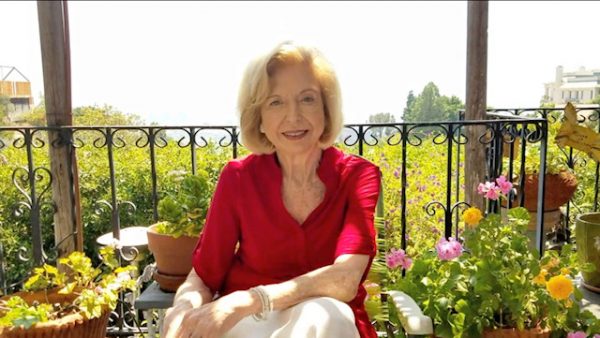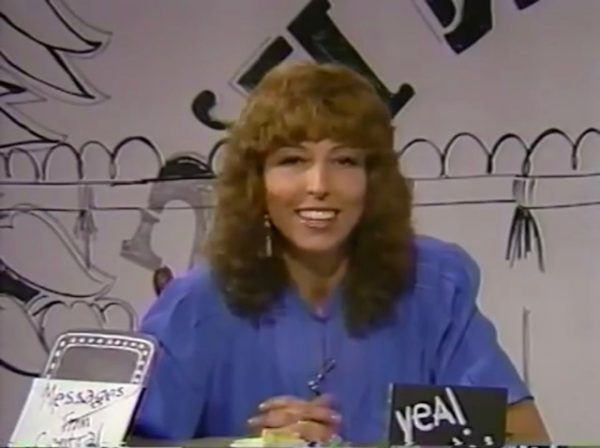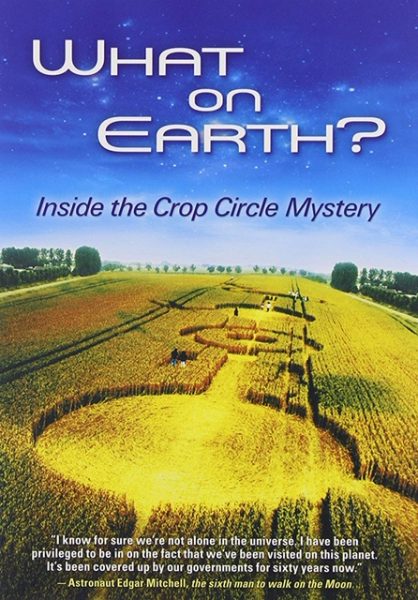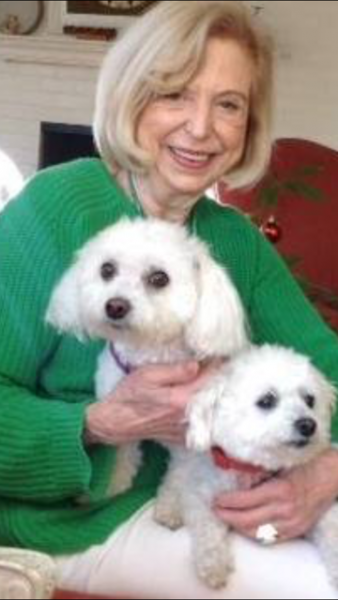
Two small, white bichon frise dogs greet meet me as I enter Suzanne Taylor’s rustic, Normandy-style home just outside West Hollywood in the Hollywood Hills. They’re as friendly as she — apropos, since increasing friendliness is her main objective as of late. Her project, “Making L.A. a Friendlier City,” (http://bit.ly/MakingLAFriendlier) is in the running for a $100,000 grant from LA2050, an org that endeavors to shape the future of Los Angeles.
I’m to talk to Suzanne today about her project, but there’s lots more I want to discuss — like her Charmin commercials, work on The Dick Van Dyke Show, and her delightful program from the early 80s that’s now blessedly on YouTube. Before we do, Suzanne zips around the tight corners of her spacious home, having me follow her into the kitchen. She makes me a cup of coffee from her single-serve Keurig and has two small plates prepared: one with crackers topped with spread and another with strawberries and pineapple. We have red cocktail napkins, toothpicks, and coffee — we are ready to roll. Now about that Charmin…
But I digress. If anyone can make L.A. a friendlier city, it’s Suzanne Taylor. She epitomizes “friendly.” She certainly doesn’t sound like she comes from Long Island. That’s not to say she’s not down to earth; she is. Yet more, she possesses a subdued sophistication. From her cherubic face framed by feathery, flaxen hair that flips at the ends, to her alert, yet soft, dewy hazel eyes, Suzanne is otherworldly. Wearing a silk red blouse, white linen pants, and matching dress sandals, she’s casually elegant. There’s not the haughtiness or condescension you might expect from someone who graduated summa cum laude from NYU, the highest distinction which required her to receive 100% on just about everything.
After college in 1961, Suzanne moved to Los Angeles to become an actress, despite her GPA. For the first few years, she rented, but in 1963, she moved into the countrylike home we’re sitting in now. The walls, the color of melted French vanilla ice cream, play up the beauty of the hardwood floors and white beam ceilings. “It’s the house that Marlo built,” she tells me.
Marlo is Marlo Thomas, star of the television show “That Girl” which ran in the late 60s to early 70s. Suzanne’s husband, a comedy writer, created the show and was its executive producer. As an actress, however, she couldn’t capitalize on her husband’s clout. Except for one Dick Van Dyke episode (her husband was story editor) he wouldn’t help her career. “Oh, he did not like me acting,” she tells me. Times being as they were, a woman’s place was in the home.
Her husband’s brainchild, “That Girl,” was a landmark show, introducing feminism across the globe. “It changed the world, in that it was a single woman having a career,” Suzanne tells me. “She did not want to get married, she didn’t need a man, so to speak.” The irony that her husband created a character who had the freedom Suzanne desired is not lost on her.
Nevertheless, Suzanne worked within the confines of wedded coffee-making and child-rearing. “That’s why I got very successful doing commercials, because you could do them for one day — I didn’t have to leave my duties as his wife.”
Though dutiful to her husband, she was incorrigible to Mr. Whipple, the fictional supermarket manager in ads for Charmin from the 60s through the 80s. Exasperated, he told her in several commercials, “Don’t squeeze the Charmin!” Cast mostly for housewife and comedic roles, Suzanne also did commercials for Windex, Purina, Jell-O, Nestle, Clorox, and more. Ask her how she was able to book so many, and she makes it sound like a no-brainer: “I was a good actress!” She also had a good commercial agent, she says. No doubt her comely looks, personality, professionalism, and on-the-ball nature helped as well. It got to the point that casting directors would look for “Sue Taylor types” (she was “Sue” at the time). As you might expect, her response was, “Well, book me!” They did.
Suzanne continued doing commercials and even painting (she had a gallery show) into the 1970s. By that time, her marriage had dissolved, and she became increasingly interested in self-development. She partook in workshops at the Esalen Institute in Big Sur, which touts itself as “the birthplace of the human potential movement.” At Esalen, she met a UC Davis professor with whom she would embark on a year-long relationship. Steeped in self-development, they started writing a book together on how to have a perfect relationship. But when the relationships ended, their book was aborted, too. Suzanne was crushed. Not so much because of the breakup, it would seem, but because her consciousness-raising book would not see the light of day. This was a turning point for Suzanne: “I thought, ‘Why am I painting pictures of flowers and why am I doing soap commercials when the world is hurting. What can I do, what can I do to help the world?’”
She stopped acting, stopped painting and looked for ways she could serve. She created a talk show opportunity for herself on L.A. public access called “Cosmic Fuel Pump,” which ran for 36 episodes. “‘Okay,’ she said to herself. “‘I’m going to sit there and spout all the things I know about how to be conscious, how to be enlightened, how to wake the world up.’” You can view a 1982 episode of Cosmic Fuel Pump on her website (suespeaks.org) in which she waxes on philosophic about forgiveness, being love, loving everybody, and our universal connection. In one episode, she soliloquizes as if on a divinely inspired rampage:

“You have to start living from your inner track, you have to start living from your spirit. You have to start letting your walls down so that your spirit merges with everybody else’s spirit. So that we get this sense of oneness. With a sense of oneness, we create peace, we create beauty, we create love. We are love. And as we feel it flow, we’re in the highest state we could possibly be in.”
“That was my favorite thing I ever did,” she tells me. She finds it funny that decades later her message remains the same.
The show, however, didn’t give Suzanne the platform to affect society the way she would have liked. “It was underground really. We couldn’t build a following, because they didn’t give us a time slot.”
Nevertheless, Suzanne would soon be lit up with new inspiration, her next project cropping up out of nowhere, literally: Crop Circles, mysterious patterns created by the flattening of crops, suggesting extraterrestrial intelligence. “If it were to be realized — that we’re not the only ones in the universe — it could change consciousness,” she says. Suzanne would be the first to tell you that many Crop Circles are created by hoaxers, but not all. Scientific research has shown some crop changes can’t be accounted for. “The lab tests prove that something is engaging with us that’s not us,” she says.
Suzanne was more than intrigued. She found someone interested in the topic and raised the money to produce a movie on Crop Circles. Knowing the topic better than the director, she ran the shoots. The movie, however, didn’t come out the way she had wanted.

“I didn’t want something about the history of crop circles! I wanted the passion of why people are so excited about them. And it was a sloppy.” She shakes her head, speaking about the turnout of “Crop Circles: Quest for Truth,” which she executive-produced.
If the movie she had wanted wasn’t made, she was going to make it — this time with total creative control. Having watched the director work on the previous film, she thought she could do what he had done — and she did. Suzanne produced and directed “What On Earth? Inside the Crop Circle Mystery” which received multiple awards and a glowing review in the New York Times. She was over the moon.
Ask her why she believes evidence of extraterrestrial life would raise consciousness, and she makes a thought-provoking sociological argument: “It would change our sense of ourselves, that we’re not the superior beings. Just like the last big change in that perspective was Copernicus and Galileo who [taught us] that we’re not the center of the universe. We went from kings and surfs to democracy. Riding on that wave, it democratized us; it brought us into a less arrogant position as humanity and this would be another move in that direction.”
After running the movie circuit, Suzanne had another idea — this one involving TED, the media org that posts talks online under the slogan “Ideas worth spreading.” “I thought, ‘they already have their platform, I don’t have to go from scratch, I will become a very important TED Producer.’”
Suzanne felt she could make a difference in the world via TED, by mending the chinks in its armor: “It purports to create a very lovely community, but it doesn’t. You don’t come off TED and meet with people. You just go and listen to TED Talks and then get online.” Wanting to leverage the platform to create a conscious community, Suzanne connected with TEDx, which focuses on local communities and voices. Soon, she got her license to produce TEDx West Hollywood.
Around the same time, a controversy broke out with two TED speakers: parapsychology researcher Rupert Sheldrake and pseudoscience theorist Graham Hancock. In Sheldrake’s talk, he suggested modern science is based on ten dogmas which don’t hold up to scrutiny; Hancock’s talk discussed the transformative impact of ayahuasca and argued for its responsible adult usage. Both status quo — challenging talks were taken out of circulation and not aired online. The backlash, Suzanne explains, was huge: “Nobel prize winners [were] pissed off at TED for taking these talks out. These guys are really substantial people who have bodies of work that are important to the world and TED took them off.”
As Suzanne was readying for her first TEDx production, her unconventional speakers grew concerned: Would TED nix their talks, too? Suzanne didn’t expect any problem. Her program was all set. Her speakers were all rehearsed. They were in the final stage of prep. “Well, two weeks before my program was supposed to go on, they cancelled my license.” It was “too fringey” and not appropriate for TEDx.
Suzanne’s license was perhaps a casualty of TED’s new 140-page rule book which restricted the content of their talks. “They have skeptics on their board. They became unhappy with some of the ‘far out’ TED Talks and [thought] that TED shouldn’t do those far out talks anymore.”
To say Suzanne was disappointed would be a staggering understatement: “I no longer had a TED license. I was going to be the inaugural program at the West Hollywood library with TED. When it was no longer TED, they couldn’t give me the library anymore. I didn’t have gravitas. I lost my sponsors because they were sponsoring TED, they weren’t sponsoring Suzanne Taylor.”
She ended up spending her own money to produce the program herself. “It’s cost me a fortune, to put this on, to rent a place. To do everything.” She needed to cover her speakers’ expenses, some of whom were flying out. The pit in her stomach is still palpable: “I had raised money from funders who took it away from me when it was no longer TED.” It wound up costing her $40,000.
Many wrote TED, asking what they had done to Suzanne. “And then TED behaved abominably,” she tells me. They sent back form letters, suggesting she was not interested in following the rules.
As if doing a commercial for lemonade (the kind you make yourself with the lemons you’re thrown), Suzanne was able to leverage her disastrous experience with TED. Someone suggested she do her own platform: It would be SUE Speaks instead of TED Talks, and SUE would stand for Searching for Unity in Everything. “There’s no site like it at all,” she gushes, referencing suespeaks.org. Featuring blog posts, videos, and podcasts, it’s a digital meeting place for high-minded people inspired to shift consciousness from a self-serving paradigm to one in which we all care about each other.
“We have to grapple with the fundamental way we run the world. We have to get serious about changing our mode, where capitalism and profit is not the be-all-end-all.” And where should the focus be instead? “The focus should be on mutuality, that we’re all in it together,” she tells me.
“Making L.A. a Friendlier City” is clearly a step in the right direction. “It’s self-organizing and it’s all set up to be passed, person to person,” she explains. Its concept is simple: Strike up a conversation with someone you don’t know: If you’re in a movie theater, talk about movies; if you’re in a supermarket, talk to somebody about the products they like. If there’s no context to discuss, Suzanne suggests you “give somebody a compliment of a non-sexual nature.” She cups her hand over her mouth, as if telling me a secret: “The truth is, it’s a wonderful pick-up device,” she whispers. “It’s so easy, you start a conversation with anybody.”
In the conversation, you tell the person you’ve approached that you’re a participant in Making L.A. a Friendlier City, and ask if they’d like to be one, too. If they’re game, they visit the Friendlier City website on their device, which explains how to participate. “You pass it along to the next person, and we get L.A. to be a real friendlier city!” she says with exuberance. She hopes to change the vibe of the whole city. “And I bet I can do it.” No doubt she already has. But with 100K, she could create a large-scale campaign, complete with billboards, hashtags, commercials, contests, and more.

As we wrap up, I ask Suzanne if there’s anything of importance we may have missed. She almost forgets, but then mentions her podcast, “Meaningful Conversations with Meaningful People.” Part of SueSpeaks.org, it debuts on Mother’s Day, May 12. “That’s my next big thing that I’m in control of,” she tells me. The intro and outro song for the show has her thrilled: “And one of the sweet things about it is my music — it is Leonard Cohen’s ‘Suzanne?’” she says, quizzically. “‘Suzanne,’ do you know his song, ‘Suzanne?’ It’s what made him famous.” No, I don’t. “Well, it’s a very famous song called ‘Suzanne’ — my name.”
“Did he write it for you?” I ask.
“No, no, no, no,” she says, laughing. “But I got permission to use it. I have permission to use all of Leonard Cohen’s material, from Leonard Cohen.”
In “Suzanne,” one of Cohen’s most-covered songs, he sings, “And she shows you where to look among the garbage and the flowers / There are heroes in the seaweed, there are children in the morning / They are leaning out for love and they will lean that way forever / While Suzanne holds her mirror.”
Are we sure he didn’t write the song for her?
To vote for “Making L.A. a Friendlier City,” simply go to (http://bit.ly/MakingLAFriendlier). Enter your zip code and confirm your vote via phone, email or Facebook (they won’t spam you, they just need this info to ensure you’re a human and not over-voting). They’ll then send you a notification to confirm your vote.

Dina Who? Have I offended you or do you mean terror for the good?
“making LA friendlier” my ass, she’s my neighbor and an absolute terror.